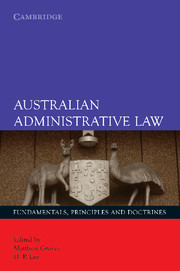Book contents
- Frontmatter
- Contents
- Foreword
- Preface
- About the contributors
- Table of cases
- Table of statutes
- 1 Australian administrative law: The constitutional and legal matrix
- 2 Administrative law in Australia: Themes and values
- 3 The public/private distinction in Australian administrative law
- 4 Australian administrative law: The human rights dimension
- 5 Administrative tribunals
- 6 Australian Ombudsman: A continual work in progress
- 7 Freedom of information
- 8 Delegated legislation
- 9 The concept of ‘justiciability’ in administrative law
- 10 Standing
- 11 Reasons for administrative decisions: Legal framework and reform
- 12 Relevant and irrelevant considerations
- 13 Improper purpose
- 14 Reasonableness, rationality and proportionality
- 15 The ‘no evidence’ rule
- 16 Failure to exercise discretion or perform duties
- 17 Procedural fairness: The hearing rule
- 18 The doctrine of substantive unfairness and the review of substantive legitimate expectations
- 19 The impact and significance of Teoh and Lam
- 20 The rule against bias
- 21 Jurisdictional error without the tears
- 22 Privative clauses and the limits of the law
- 23 Administrative law judicial remedies
- Endnotes
- Index
19 - The impact and significance of Teoh and Lam
Published online by Cambridge University Press: 05 June 2012
- Frontmatter
- Contents
- Foreword
- Preface
- About the contributors
- Table of cases
- Table of statutes
- 1 Australian administrative law: The constitutional and legal matrix
- 2 Administrative law in Australia: Themes and values
- 3 The public/private distinction in Australian administrative law
- 4 Australian administrative law: The human rights dimension
- 5 Administrative tribunals
- 6 Australian Ombudsman: A continual work in progress
- 7 Freedom of information
- 8 Delegated legislation
- 9 The concept of ‘justiciability’ in administrative law
- 10 Standing
- 11 Reasons for administrative decisions: Legal framework and reform
- 12 Relevant and irrelevant considerations
- 13 Improper purpose
- 14 Reasonableness, rationality and proportionality
- 15 The ‘no evidence’ rule
- 16 Failure to exercise discretion or perform duties
- 17 Procedural fairness: The hearing rule
- 18 The doctrine of substantive unfairness and the review of substantive legitimate expectations
- 19 The impact and significance of Teoh and Lam
- 20 The rule against bias
- 21 Jurisdictional error without the tears
- 22 Privative clauses and the limits of the law
- 23 Administrative law judicial remedies
- Endnotes
- Index
Summary
There are many similarities in the factual and legal foundations of the High Court cases of Minister for Immigration and Ethnic Affairs v Teoh (Teoh) and Re Minister for Immigration and Multicultural Affairs; Ex parte Lam (Lam). Both Teoh and Lam concern individuals who were facing the revocation of their Australian entry visas, and consequently deportation, due to drug offences. In challenging these decisions, both Mr Teoh and Mr Lam claimed that they had been denied procedural fairness on the basis that they had a legitimate expectation that a course of conduct would be pursued by officers of the Department of Immigration and Multicultural/Ethnic Affairs. Both men were fathers of Australian citizens and provided testimonials to the effect that it was in the best interests of their children that they remain in Australia rather than be returned to their country of origin. At this point the similarities end.
The High Court's decision in Teoh was ‘taken to the streets’ due to the importance attached by the Court to Australia's ratification of an international treaty, the Convention on the Rights of the Child, in domestic law. Lam did not excite any public controversy (except perhaps amongst administrative lawyers). Teoh was regarded as a significant development in the doctrine of legitimate expectations in Australian administrative law, whereas Lam appeared to spell a retreat from the concept.
- Type
- Chapter
- Information
- Australian Administrative LawFundamentals, Principles and Doctrines, pp. 299 - 315Publisher: Cambridge University PressPrint publication year: 2007
- 1
- Cited by



